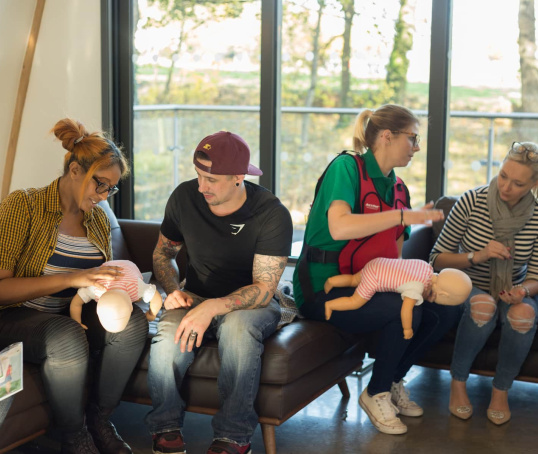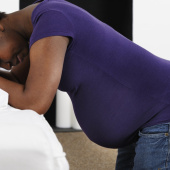Various methods are rumoured to bring on labour, but do they work? And are they safe? We look at the truth behind some of the most popular.
Is the due date accurate?
Medical professionals use Naegele’s rule to calculate the estimated due date. This adds 280 days to the first day of the last period (Lawson, 2020).
But this rule, dating from the 19th century, is only a guideline. Pregnancies can vary in length by 37 days, which is over five weeks. This might be affected by several factors including ethnicity, height, and variations in the menstrual cycle (Lawson, 2020; Jukic et al, 2013).
The ultrasound scan offered between 11 and 14 weeks provides an estimated due date or EDD (NICE, 2021a). But the definition of a ‘term’ pregnancy is anything between 37 and 42 weeks.
What starts labour?
While it’s not yet clear, the available evidence suggests a mix of hormonal and mechanical factors bring on labour. They might be started by the mother or birthing person, or the baby (Hundley et al, 2020).
What do people say can bring on labour?
Despite the lack of evidence, there are lots of claims for naturally inducing labour.
There is some argument for:
Gentle exercise
Walking is the most common method used to encourage labour at the end of pregnancy (Chaudhury, 2011). Rocking on a birthing ball, or climbing stairs are also frequently suggested as ways to encourage labour. The idea is that exercise moves the pelvis, helping the baby to move down and put pressure on the cervix.
Staying active and fit in pregnancy will help adapt to a changing shape and cope with labour, though exercise will tend to slow and reduce as the pregnancy puts more demands on the body.
Breast stimulation
Research shows that breast stimulation increases the number of women in labour within 72 hours. It encourages the body to produce oxytocin, the same hormone that causes contractions in labour (Kavanagh et al, 2005).
Women in the research performed gentle breast massage or nipple stimulation on one breast at a time, for a total of one to three hours a day (Kavanagh et al, 2005). Breast stimulation can include the whole breast, and not just the nipple, which can be painful (Singh et al, 2014).
Because the research was not done in women with more complicated pregnancies, the researchers cannot say if it would be harmful or safe in those pregnancies (Kavanagh et al, 2005).
Eating dates
One very small study in Jordan found that eating six dates a day for four weeks before the EDD could help women go into labour spontaneously, avoiding induction. The first stage of labour was also shorter (Al- Kuran et al, 2011). It’s possible that the dates help keep the bowels clear, and so have a mechanical effect.
There is no evidence for:
Eating spicy food
Some pregnant women try eating spicier food than usual (Chaudhry et al, 2011). There’s no research showing it has the desired effect of bringing on labour, though it won’t do any harm. Those prone to heartburn during pregnancy might want to avoid eating spicy food if it’s not a part of their usual diet.
Raspberry leaf tea or tablets
Raspberry leaf is a traditional remedy used by expectant parents. Raspberry leaf is believed to tone the uterus, making contractions more effective and labour shorter (Holst et al, 2009; Farnaghi & Braniff, 2022).
The small amount of research that exists suggests that it might shorten labour, but there is nothing to suggest it starts it off (Bowman et al, 2021; Bowman et al, 2024).
Sex
Having sex or an orgasm increases levels of oxytocin – the ‘love hormone’ – which contracts the uterus. Semen is rich in prostaglandins, which are present when the cervix softens in early labour. Prostaglandins are the chemical used in hospital inductions.
While sex is commonly used by parents in the hope of starting labour, there is no evidence that it makes a difference (Kavanagh et al, 2001; Chaudhry et al, 2011). The lack of evidence is because the small amount of research that has been done is low quality or didn’t give conclusive results.
Whatever the outcome, sex late in pregnancy usually won’t harm the baby. Read our article on sex in pregnancy.
Complementary therapies
Therapies such as aromatherapy, reflexology, acupuncture and pregnancy massage are sometimes suggested to encourage the start of labour. But there is very little research available.
Where there is research, there is no evidence that using homeopathy or hypnosis have any effect on labour starting (Nishi et al, 2014; Smith, 2003). While some research found that acupuncture or acupressure softened the cervix, this did not mean the women who had these therapies would soon go into labour (Smith et al, 2017).
However, complementary therapy may help with relaxation. Tell the practitioner about the pregnancy, and make sure they have experience and training in treating pregnant clients.
Anything to avoid?
While these might be suggested, they’re more likely to make the pregnant woman or person unwell (NICE, 2021b):
- Castor oil – likely to induce nausea
- Herbal supplements – are not well researched so cannot be confirmed to be safe
- Hot baths – could make the pregnant woman or person feel faint
What happens if labour doesn’t start?
Pregnant women and people will be offered information on induction from 38 weeks of pregnancy (NICE, 2021a). They should be given time to think about it and discuss it with their partner, if they have one, before they make a decision.
The alternative to induction is expectant management (NICE, 2021b). This means the pregnant woman or parent and baby will be monitored more closely. Take a look at our article on induction of labour.
Further information
Our NCT New Baby course supports new parents and their babies, giving you all the tools you need to make the transition to parenthood a little bit easier.
Al-Kuran O, et al (2011) The effect of late pregnancy consumption of date fruit on labour and delivery. Journal of Obtetrics and Gynaecology 31(1):29-31. https://doi.org/10.3109/01443615.2010.522267
Bowman, R. et al (2021) Biophysical effects, safety and efficacy of raspberry leaf use in pregnancy: a systematic integrative review. BMC Complement Med Ther, 21, 56. https://doi.org/10.1186/s12906-021-03230-4
Bowman, R.L., Taylor, J. & Davis, D.L. (2024) Raspberry leaf (Rubus idaeus) use in pregnancy: a prospective observational study. BMC Complement Med Ther, 24, 169. https://doi.org/10.1186/s12906-024-04465-7
Chaudhry Z et al (2011) Women’s use of nonprescribed methods to induce labor: a brief report. Birth (38):168–171. https://doi.org/10.1111/j.1523-536x.2010.00465.x
Farnaghi S, Braniff K (2022) Survey of Raspberry Leaf Tea in pregnancy. Australian & New Zealand journal of obstetrics & gynaecology, 62(4), 506‐510. https://doi.org/10.1111/ajo.13496
Holst L, Haavik S, Nordeng H (2009) Raspberry leaf – Should it be recommended to pregnant women? Complementary Therapies in Clinical Practice, 15 (4) pp 204-208. https://doi.org/10.1016/j.ctcp.2009.05.003
Hundley V, Downe S, Buckley SJ (2020) The initiation of labour at term gestation: Physiology and practice implications. Best Practice & Research Clinical Obstetrics & Gynaecology, 67 (4) 18. https://doi.org/10.1016/j.bpobgyn.2020.02.006
Jukic AM et al (2013) Length of human pregnancy and contributors to its natural variation. Human Reproduction. 28(10):2848-2855. https://doi.org/10.1093/humrep/det297
Kavanagh J et al (2005) Breast stimulation for cervical ripening and induction of labour. Cochrane Database of Systematic Reviews. (3):CD003392. https://doi.org/10.1002/14651858.CD003392.pub2
Kavanagh J et al (2001) Sexual intercourse for cervical ripening and induction of labour. Cochrane Database of Systematic Reviews. (2):CD003093. https://doi.org/10.1002/14651858.CD003093
Lawson, G.W. (2020), Naegele’s rule and the length of pregnancy – A review. Aust N Z J Obstet Gynaecol, 61: 177-182. https://doi.org/10.1111/ajo.13253
NICE (2021a) Antenatal care [NG201]. https://www.nice.org.uk/guidance/ng201 [21 Nov 24]
NICE (2021b) Inducing labour [NG207]. https://www.nice.org.uk/guidance/ng207 [21 Nov 24]








